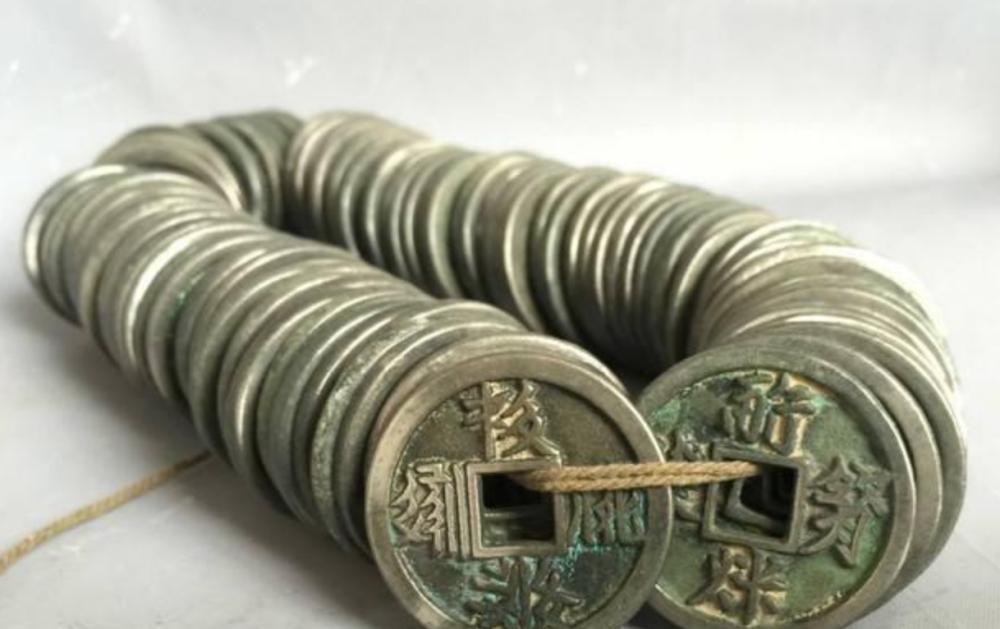In daily life, we describe a person who has money, often used as a metaphor for family wealth and money entanglement, the 13th time in the Qing Dynasty public case novel "Liu Gong Case": "The good land earned is thousands of acres, the family wealth is thousands, and there is a lot of face in the province and county." "Su Dongpo also has a poem: 100,000 yuan wrapped around his waist, riding a crane down to Yangzhou.

It can be seen that in ancient times, whether it was ten thousand or ten thousand family wealth, it was a considerable wealth. But if you look closely, how much money is 10,000 yuan of family property? Here's a quick explanation.
In the history of continental numismatics, both copper and iron have been used to mint money. The use of iron to mint money began in the Western Han Dynasty and reached its peak in the Northern Song Dynasty. Now we often hear from time to time from archaeological news reports of 100 pounds of iron money unearthed in a certain place.
Since the Qin and Han dynasties, mainland coins have been dominated by ring-shaped coins, with outer circles and inner squares, which is the origin of another name for coins, "Brother Kong Fang". Coins of the Han Dynasty are called five baht coins because they weigh five baht, which is calculated as 250 grams per pound in the Western Han Dynasty, about 0.65 grams per baht, and about 3.25 grams for five baht. Converted down, 1,000 five-baht coins weigh a total of 3250 grams, just six and a half pounds.
In the Tang Dynasty, after Li Yuan ascended the throne, he abolished Sui money, followed the strict specifications of the Western Han Dynasty's five baht, and began to cast "Kaiyuan Tongbao". Because the weight of Kaiyuan Tongbao is stable and can be used as a balance code, "money" has become a unit of weight. Ten dollars for one or two, one hundred and sixty dollars is a pound. The standard of money has always been a thousand words, and the weight is about six pounds and three or two, and this is a lot of money.
Now the answer is out, and the coins of the family are piled together, and the total weight is about 63,000-65,000 pounds, which can fill the whole room. However, from the late Tang Dynasty onwards, the standard of consistent money began to shrink, and in the areas controlled by different feudal towns, some were 950 texts for consistency, 900 texts for consistency, and even 750 texts for consistency. In the Song Dynasty, there was a distinction between "foot pass" and "provincial mo", foot pass = 1000 text, provincial mo = 800 text or 770 text or 700 text.
During the Ming and Qing dynasties, the common people liked to use "hanging" as a unit of copper coins, 100 texts is equal to 1 hanging, so calculated, a hanging money is now more than six or two. Whether it is a long or hanging, once the money is more, it is a lot of money. The so-called waist is entangled, let alone wrapped around the body, can bury people.
Therefore, the waist is just the imagination of a few students, counting the weight, there are sixty thousand pounds, wrapped around the body, not to mention entangled, entangled can not move. The ancients are also outrageous, in the novel "Fifteen Consecutive Jokes Become a Coincidence", Cui Ning was wrongfully robbed of Liu Gui's fifteen consecutive dollars, and the arm that opened his back was exactly 15 consecutive dollars, which was not bad. 15 tubes of money weigh about 100 pounds, even if it can be packed into the arm, it is very inconvenient to move on the body.
From the purchasing power, let's take a look at the ten thousand yuan, how big a fortune it is.
Taking the Ming Dynasty as an example, in the middle and late Ming Dynasty, silver has been very popular. In ordinary years, one or two pieces of silver are about 700 yuan, and the usual money is about 1.4-1.5 two pieces of silver. According to the "Ming Dynasty Official Composition Change and the Initiation of the Equalization Law", the daily income of Ming Dynasty craftsmen, if settled with copper coins, is most common in more than 20-30 texts, calculated down, a month without rest, its income is only about one or two silver.
However, the price of the Ming Dynasty was also relatively low, a family of three, a day to eat about 3 kilograms of rice, plus a little side food, the daily living expenses of about 20 yuan. In short, a craftsman's daily income is barely enough to make a living for the family. If the family is overpopulated, it is difficult to support itself by one person. This is also recorded in the notes of the Ming Dynasty: poor domestic workers in the capital receive twenty-four or five yuan a day, only enough to feed, three winter months, no clothes.
Some researchers also estimate that during the wanli years when the Ming Dynasty was the richest, the price of one stone of rice fluctuated between 7 yuan and 1 silver, and 1 stone of rice in the Ming Dynasty was slightly equivalent to about 140 jin today, that is to say, one or two silver in the Ming Dynasty was about 400 yuan now. According to this estimate, the family property of Wanguan is equivalent to about five or six million yuan today. In second- and third-tier cities, it can be regarded as the middle class!